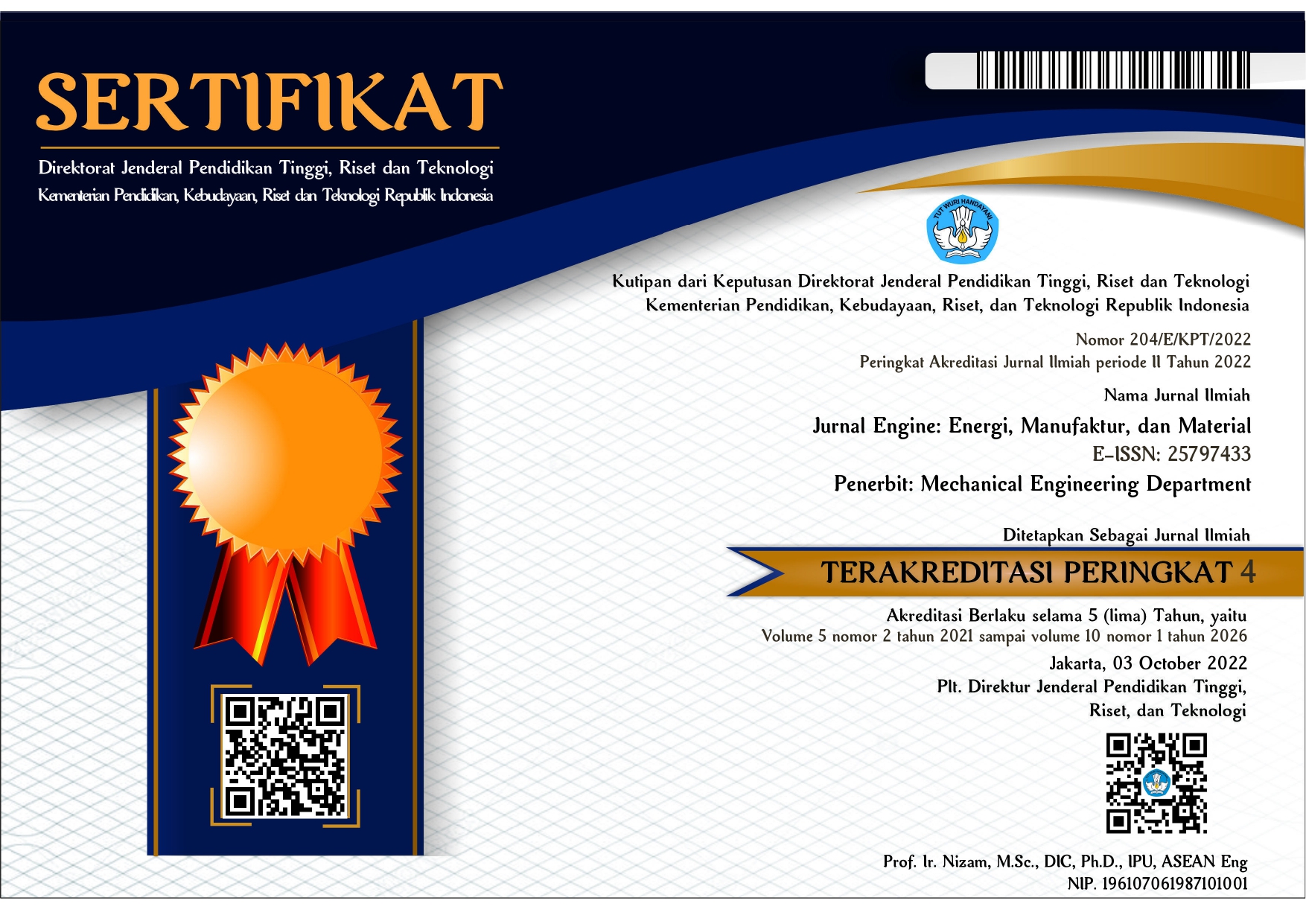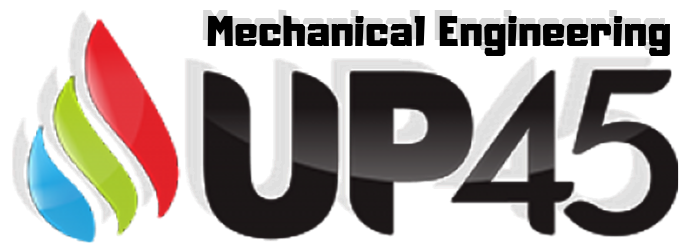Rancang Bangun Mesin CNC Lathe Mini 2 Axis
DOI:
https://doi.org/10.30588/jeemm.v4i2.769Keywords:
lathe machine, mesin bubut, mini-lathe CNC, CNC lathe mini, 2 axis, design, rancang bangun, aluminum A6061, alumunium A6061Abstract
The use of a lathe that is controlled by computer numerical controlled (CNC) with high speed and good dimensional accuracy, so it uses less human resources. The use of CNC machines is increasing rapidly, along with factory automation. Therefore, the need for skilled CNC machine design experts is increasing. The development of a CNC lathe that is strong and easy to move from one place to another is a necessity for educational institutions with limited space to practice CNC lathes for their students. In this research, the design and manufacture of a strong and self-produced 2 axis mini-lathe machine prototype were carried out. The method used in designing the structure of the machine, and selecting the electric motor to drive the spindle, and the stepper motor to drive the chisel. The results of this study obtained a 2 axis mini-lathe CNC machine with predetermined electronic components, so that it has a design torque of the spindle motor of 4.7454 Nm and a speed of 1,500 rpm, with a stepper motor power of 36 W, with a cutting speed of 90 m min. This CNC machine can work on aluminum material in the experimental process of the infeed depth used is 0.5 mm/rotation with a maximum cutting speed (feed-rate) of 0.75 m/minute. It is recommended to use a low feed rate in machining. The axial force on the stepper motor is 1,368 N with a tool pressure when machining of 912 MPa so that it can cut the A6061 type aluminum material with a yield point of 145 MPa. In the future research can be developed using a material that is tougher than aluminum in order to measure the maximum capabilities of the machine.
Penggunaan mesin bubut yang dikendalikan oleh computer numerical controlled (CNC) dengan kecepatan tinggi dan akurasi dimesi yang bagus, sehingga penggunakan tenaga kerja yang lebih sedikit. Penggunaan mesin CNC meningkat pesat seiring dengan berjalannya otomatisasi pabrik. Oleh karena itu, kebutuhan tenaga ahli di bidang perancangan mesin CNC yang terlatih semakin meningkat. Pengembangan mesin bubut CNC yang kuat dan mudah dipindahkan dari satu tempat ketempat yang lain merupakan kebutuhan lembaga pendidikan dengan ruang yang terbatas untuk melakukan praktik mesin bubut CNC kepada siswanya. Dalam penelitian ini, dilakukan perancangan dan pembuatan prototipe mesin bubut CNC lathe mini 2 axis yang kuat dan dapat diproduksi sendiri. Metode yang dipakai adalah merancang struktur dari mesin, dan melakukan pemilihan motor listrik sebagai penggerak spindle, serta motor stepper sebagai penggerak pahat. Hasil dari penelitian ini didapat mesin CNC lathe mini 2 axis dengan komponen elektronik yang sudah ditentukan, sehingga mempunyai rancangan torsi motor penggerak spindle sebesar 4,7454 Nm dan kecepatan 1.500 rpm, dengan daya motor stepper 36 W, dengan kecepatan potong 90 m/menit. Mesin CNC ini mampu mengerjakan material aluminium pada proses percobaan kedalaman pemakanan yang dipakai 0,5 mm/putaran dengan kecepatan penyayatan (feedrate) maksimal 0,75 m/menit. Disarankan menggunakan feedrate kecil dalam permesinan. Gaya aksial pada motor stepper sebesar 1.368 N dengan tekanan pahat saat permesinan sebesar 912 MPa, maka mampu menyayat material bahan alumunium tipe A6061 yang yield point sebesar 145 MPa. Kedepannya dapat dikembangkan penelitian dengan menggunakan material yang lebih keras dari aluminium agar dapat mengukur kemampuan maksimal dari mesin.
References
Ardi, S., & Rediyanto, R. (2015). Retrofit Sistem Kontrol Mesin Press Dust Cover di Line Produksi Manufaktur Berbasis Programmable Logic Controller. Jurnal Teknologi Elektro, 6(3), 207-220. doi:10.22441/jte.v6i3.808
Avallone, E. A., Baumeister, T., & Sadegh, A. (2006). Marks’ Standard Handbook For Mechanical Engineers (11th ed.). New Yorks, USA: McGraw-Hill Professional.
Herliansyah, M. K. (2005). Pengembangan CNC Retrofit Milling untuk Meningkatkan Kemampuan Mesin Milling Manual dalam Pemesinan Bentuk-bentuk Kompleks. Forum Teknik, 29(1), 62-70.
Herwan, J., Kano, S., Ryabov, O., Sawada, H., Kasashima, N., & Misaka, T. (2019). Retrofitting Old CNC Turning with an Accelerometer at a Remote Location towards Industry 4.0. Manufacturing Letters, 21, 56-59. doi:10.1016/j.mfglet.2019.08.001
Jufrizaldy, M., Ilyas, I., & Marzuki, M. (2020). Rancang Bangun Mesin CNC Milling Menggunakan Menggunakan System Kontrol GRBL untuk Pembuatan Layout PCB. Jurnal Mesin Sains Terapan, 4(1), 37-44.
Nishal, M., Prasad, K. R., Karthik Balaji, T. V., & Kalaivanan, K. (2020). Retrofit of two way holding chuck to improve process efficiency and resource management. Materials Today: Proceedings, 10-14. doi:10.1016/j.matpr.2020.08.024
Pramono, G. E., Supriatma, E., & Sutisna, S. P. (2017). Retrofit Motor Stepper Mesin CNC 3 Axis UIKA Prototype 3. Jurnal Ilmiah Teknik Mesin, 3(2), 60-66. doi:10.32832/ame.v3i2.770
Riawan, M. A., Karuniawan, B. W., & Hamzah, F. (2018). Rancang Bangun CNC Router Kayu dengan Menggunakan Control Mach 3. Proceedings Conference on Design Manufacture Engineering and Its Application, 1(1), 197-204.
Setiawan, B., Rasma, R., & Djunaedi, T. (2020). Rancang Bangun Mesin CNC Router Portable dengan Dimensi 1219x609 mm untuk Skala Laboratorium. INFOMATEK: Jurnal Informatika, Manajemen dan Teknologi, 22(1), 15-22. doi:10.23969/infomatek.v22i1.2747
van Houten, F. A. (1992). Manufacturing Interfaces. CIRP Annals, 41(2), 699-710. doi:10.1016/S0007-8506(07)63256-9
Downloads
Published
How to Cite
Issue
Section
License
Authors who publish with Jurnal Engine: Energi, Manufaktur, dan Material agree to the following terms:
Authors retain copyright and grant the Jurnal Engine: Energi, Manufaktur, dan Material right of first publication with the work simultaneously licensed under a Creative Commons Attribution 4.0 International License that allows others to share (copy and redistribute the material in any medium or format) and adapt (remix, transform, and build upon the material) the work for any purpose, even commercially with an acknowledgment of the work's authorship and initial publication in Jurnal Engine: Energi, Manufaktur, dan Material. Authors are able to enter into separate, additional contractual arrangements for the non-exclusive distribution of the journal's published version of the work (e.g., post it to an institutional repository or publish it in a book), with an acknowledgment of its initial publication in Jurnal Engine: Energi, Manufaktur, dan Material. Authors are permitted and encouraged to post their work online (e.g., in institutional repositories or on their website) prior to and during the submission process, as it can lead to productive exchanges, as well as earlier and greater citation of published work (See The Effect of Open Access).


















